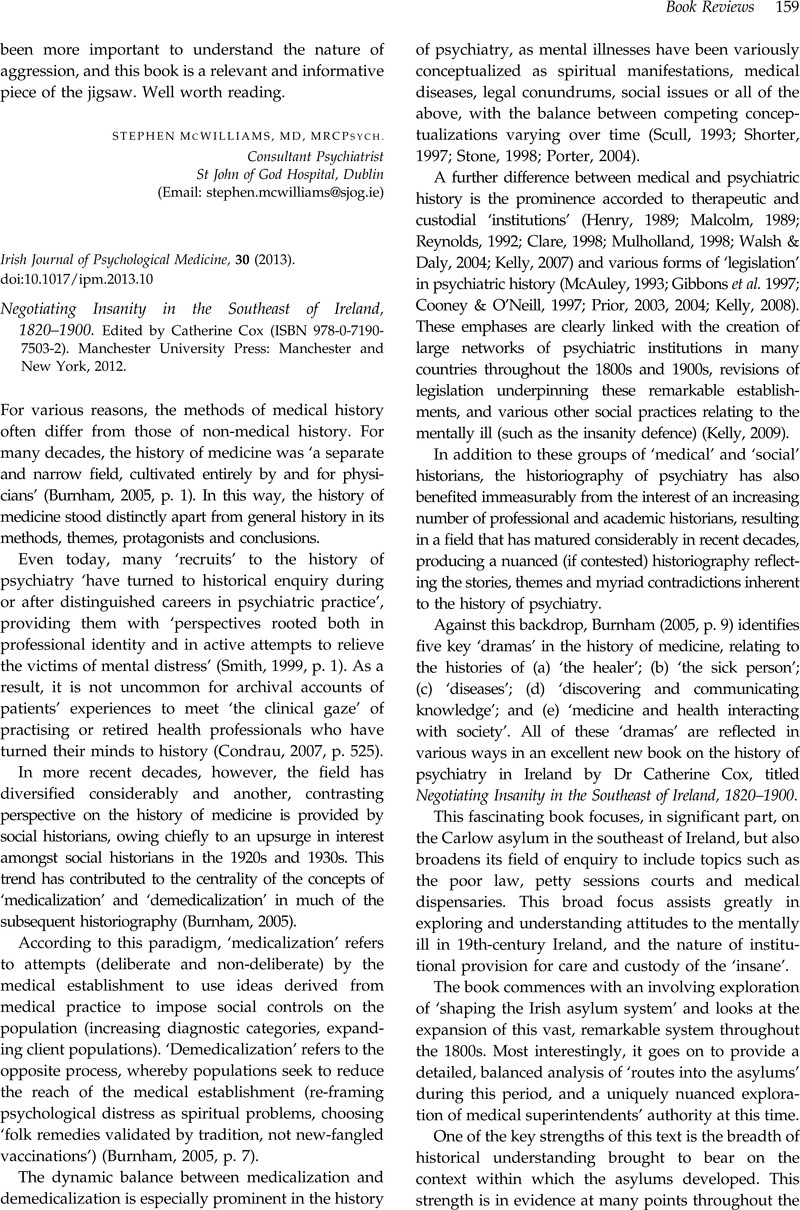No CrossRef data available.
Article contents
‘Negotiating Insanity in the Southeast of Ireland, 1820–1900’ Edited by Catherine Cox (ISBN 978-0-7190-7503-2.) Manchester University Press: Manchester and New York, 2012.
Published online by Cambridge University Press: 21 May 2013
Abstract
An abstract is not available for this content so a preview has been provided. Please use the Get access link above for information on how to access this content.

- Type
- Book Reviews
- Information
- Copyright
- Copyright © College of Psychiatrists of Ireland 2013
References
Clare, AW (1998). St. Patrick's Hospital. American Journal of Psychiatry 155, 1599.CrossRefGoogle ScholarPubMed
Condrau, F (2007). The patient's view meets the clinical gaze. Social History of Medicine 20, 525–540.CrossRefGoogle Scholar
Cooney, T, O'Neill, O (1997). Psychiatric Detention: Civil Commitment in Ireland (Kritik 1). Baikonur: Wicklow.Google Scholar
Gibbons, P, Mulryan, N, O'Connor, AG (1997). Guilty but insane: the insanity defence in Ireland, 1850–1995. British Journal of Psychiatry 170, 467–472.CrossRefGoogle ScholarPubMed
Henry, HM (1989). Our Lady's Hospital, Cork: History of the Mental Hospital in Cork Spanning 200 Years. Haven Books: Cork.Google Scholar
Kelly, BD (2007). One hundred years ago: the Richmond Asylum, Dublin in 1907. Irish Journal of Psychological Medicine 24, 108–114.CrossRefGoogle ScholarPubMed
Kelly, BD (2008). The Mental Treatment Act 1945 in Ireland: an historical enquiry. History of Psychiatry 19, 47–67.CrossRefGoogle ScholarPubMed
Kelly, BD (2009). Criminal insanity in nineteenth-century Ireland, Europe and the United States: cases, contexts and controversies. International Journal of Law and Psychiatry 32, 362–368.CrossRefGoogle ScholarPubMed
Malcolm, E (1989). Swift's Hospital: A History of St Patrick's Hospital, Dublin, 1746–1989. Gill and Macmillan: Dublin.Google Scholar
McAuley, F (1993). Insanity, Psychiatry and Criminal Responsibility. Round Hall Press: Dublin.Google Scholar
McCarthy, A (2004). Hearths, bodies and minds: gender ideology and women's committal to Enniscorthy Lunatic Asylum, 1916–1925. In Irish Women's History (ed. A. Hayes and D. Urquhart), pp. 115–136. Irish Academic Press: Dublin and Portland, OR.Google Scholar
Mulholland, M (1998). To Comfort Always: A History of Holywell Hospital, 1898–1998. Homefirst Community Trust: Ballymena.Google Scholar
Porter, R (2004). Madmen: A Social History of Madhouses, Mad-Doctors and Lunatics. Tempus: Gloucestershire.Google Scholar
Prior, P (2003). Dangerous lunacy: the misuse of mental health law in nineteenth-century Ireland. Journal of Forensic Psychiatry and Psychology 14, 525–541.CrossRefGoogle Scholar
Prior, P (2004). Prisoner or patient? The official debate on the criminal lunatic in nineteenth-century Ireland. History of Psychiatry 15, 177–192.CrossRefGoogle ScholarPubMed
Reynolds, J (1992). Grangegorman: Psychiatric Care in Dublin Since 1815. Institute of Public Administration in Association with Eastern Health Board: Dublin.Google Scholar
Scull, A (1993). The Most Solitary of Afflictions: Madness and Society in Britain, 1700–1900. Yale University Press: New Haven and London.Google Scholar
Shorter, E (1997). A History of Psychiatry: From the Era of the Asylum to the Age of Prozac. John Wiley and Sons: New York.Google Scholar
Smith, L (1999). ‘Cure, Comfort and Safe Custody’: Public Lunatic Asylums in Early Nineteenth-Century England. Leicester University Press: London and New York.Google Scholar
Stone, MH (1998). Healing the Mind: A History of Psychiatry from Antiquity to the Present. Pimlico: London.Google Scholar
Walsh, D, Daly, A (2004). Mental Illness in Ireland, 1750–2002: Reflections on the Rise and Fall of Institutional Care. Health Research Board: Dublin.Google Scholar
Walsh, O (2004). Gender and insanity in nineteenth-century Ireland. Clio Medica 73, 69–93.Google ScholarPubMed


